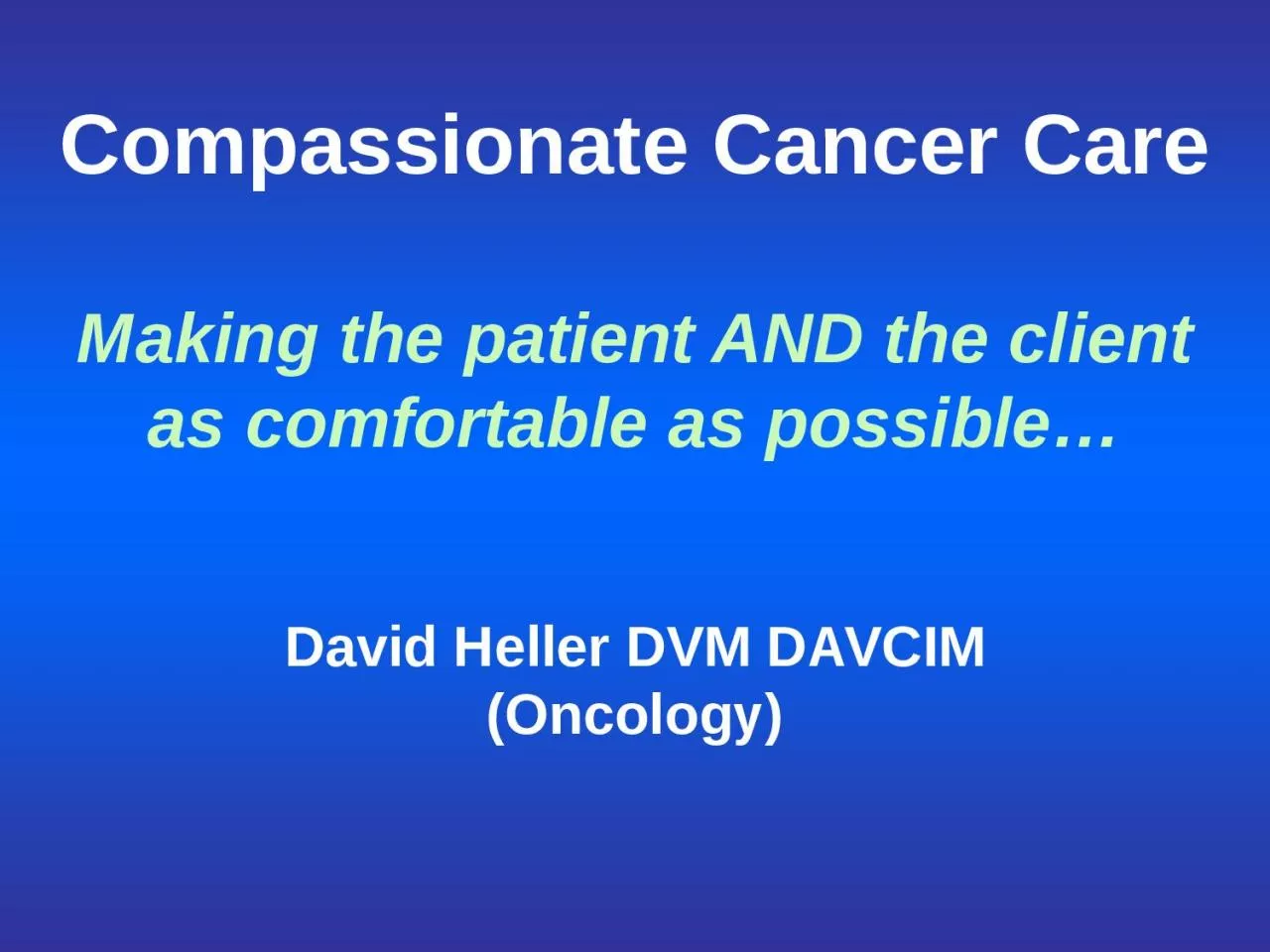

Making the patient AND the client as comfortable as possible David Heller DVM DAVCIM Oncology Outline Delivering bad news Terminology realistic expectations Helping owners to understand ID: 1036838
Download Presentation The PPT/PDF document "Compassionate Cancer Care" is the property of its rightful owner. Permission is granted to download and print the materials on this web site for personal, non-commercial use only, and to display it on your personal computer provided you do not modify the materials and that you retain all copyright notices contained in the materials. By downloading content from our website, you accept the terms of this agreement.
1. Compassionate Cancer CareMaking the patient AND the client as comfortable as possible…David Heller DVM DAVCIM (Oncology)
2. OutlineDelivering bad newsTerminology, realistic expectationsHelping owners to understandDifferences in companion animals vs. peopleStigmas still exitsPain controlEmphasize to owners early onPain management in dogs and cats with different stages of disease
3. Why this topic??Cancer discussion is difficult for most doctorsQuality of life is of utmost importance in our practice73% of human cancer patients report pain as a consequence of disease, 36% classify pain as “intolerable”“Tolerance” is quite different in animals vs people
4. What about pets?Estimate: 50% of cancer-bearing & feel pain?Difficulty to identifyBarriers:Recognizing painEvaluate and re-evaluate severityFear or lack of understanding of certain analgesic drugsSuboptimal communication with clients
5. Keeping the owners comfortable…Deliver news sensitively, compassionatelyHave patience for repeated questionsAssist their decision-makingReassure their decisionsCrisis “contingency” plan
6. …And helping their grieving processNormal vs. anticipatory griefSymptoms of grief can be physical, emotional, social, spiritualInvolve children and other family members
7. The “final act” of kindnessPreparing for euthanasiaWhere, when, who ahead of timeIn-home euthanasia services After-death follow-up
8. Cancer PainTumors commonly associated with cancer pain:Bone tumorsNervous systemGI, especially oral and pharyngealGenitourinary, prostateNasal tumorsMetastatic disease, carcinomatosisVisceral organs (spleen, liver, kidney)
9. Pain: classificationTemporal: acute, chronic, intermittentIntensity: mild, moderate, severe, “unbearable”/excruciatingType: somatic, visceral, neuropathicEtiology: primary tumor, metastases, PN syndromes, Dx or Tx procedures, concurrent conditions
10. Approach to Cancer Pain ManagementAssess the painQuestionnaires Believe the ownerThey know their pet the bestChoose appropriate therapyConsider all factorsDeliver the therapy in a logical fashionEmpower the clients Fosters strong bond, good will
11. Chronic pain in veterinary cancer patients?Peripheral and central sensitization, and wind-up common with certain veterinary cancersExamples:OSA +/- DJDDegranulating MCTOral SCCVASTSNasal ACAInflamm. carcinoma
12. Standard analgesic therapyImportant part of cancer pain therapyNSAIDsOpioidsLocal and α-2 agonistsAdjuvant analgesicsComplementary or alternative therapies
13. NSAIDsMany veterinary approvedNone approved for cancer painCOX selectivity?Minimum DB on geriatric patient Massive utilization for cancer pain in humans & pets
14. NSAID for cancer pain: wise choice?PGs: important role in nociceptor (peripheral) sensitization and in central sensitizationNSAIDs useful for mild to moderate painAlso for severe pain: better in combination Humans with carcinomatosis, bone metastases
15. OncogenesCytokinesGrowth factorsMitogensCox-2 Effects on cells?Tumor suppressorsCOX-2 & cancer: what’s the link?
16. Veterinary cancers overexpressing COX-2Carcinomas: bladder, prostate, GI, sinonasal, squamous cell, mammary, renalOsteosarcomaMalignant melanoma“Hit two birds with one stone?”
17. OpioidsDominant analgesic class for cancer pain therapy in humansShould also be the case with & Dosage can be for desired analgesiaSide effects vs. Better analgesia when in combination
18. MorphineStandard opioid to which others are compared Pure agonist of receptorsCheap, predictable and tolerable side effects, many routes of administration For chronic pain: oral administration
19. agonistsFentanyl, oxy- & hydromorphone, oxycodone, meperidineVery useful for cancer painMany routes of administrationLess histamine release than with morphineSide effects?
20. BuprenorphinePartial agonistLong actionTransmucosal in catsUseful for breakthrough pain
21. ButorphanolMixed: agonist, antagonistInadequate analgesic for moderate to severe painLess potent than pure agonistsShort duration of action (20 min. to 1 hr)Sedation lasts longer – false sense of clinical improvement
22. “Weak” opioidsCodeineTramadolChronic pain, cancer related or not, in people and petsAlso inhibits serotonin and norepinephrine reuptakeLess side effects than with “true opioids” in dogs
23. Local analgesicsLido-, bupi-, mepivacaineMechanism of actionLocal or regional blocksTopical use (patches)IV infusion
24. 2 agonistsXylazine and medetomidineUseful for proceduresGenerally combined with opioid, or others – better analgesiaGeriatric patients?Repeated use safe if patient otherwise healthy “Age is not a disease!”
25. NMDA receptor antagonistsN-methyl-D-aspartate receptorsCNS dorsal hornTransmission of nociceptive signalsCentral sensitization leading to establishment of chronic pain stateKetamine – constant infusion (microdose)Amantadine – oralMethadoneTiletamine
26. Tricyclic antidepressantsAmitriptyline & clomipramineInhibit serotonin and norepinephrine reuptakeAlso antihistamine effectHistamine & serotonin potentiate nociceptive signals in CNSCombination with other analgesicsLittle effect when used aloneChronic pain
27. AnticonvulsantsCan be very helpful for chronic pain with central sensitization of neuropathic painGabapentin is the main oneStructural analogue of GABAAntagonistic effect on NMDA receptorsWorks better in combinationWell tolerated
28. BisphosphonatesSpecifically for osteolytic bone painSites of bone remodelingAnti-osteoclastic effectsBone pain: IV aminobisphosphonates preferred (pamidronate, zoledronate)Other usages: 1° HyperPTH, HCM (HHM)Safety in cancer-bearing dogs
29.
30. CorticosteroidsLow dose, can be relatively useful for cancer painWeak analgesic effectMostly useful when inflammation plays a roleDO NOT use with an NSAID!Side effectsVitamin P!
31. NutraceuticalsGlucosamine/chondroitinOccasionally usefulCombination with NSAIDAnti-inflammatory and analgesic effects
32. Alternative therapiesCan be useful for cancer painAcupuncture, massage, hydrotherapy, U/S, laser therapy, electromyostimulation, magnetic pulsation, …
33. Recommendations – client careDiscuss with the client:Any quality of life concernsA reasonable life expectancyKeeping their loved one as comfortable as possible, all the timeNutritional therapy
34. Recommendations – patient careBe cognizant of painful tumor typesAdopt a pain assessing program that is reliableInstitute pain management earlyPain alleviation with multimodality treatment options are the bestDirectAdjuvant
35. David Heller DVM MS DACVIM (Oncology)California Veterinary SpecialistsOntario, CAdhellerdvm@yahoo.com